 In delivering his Budget on 22 November, Philip Hammond reported that the independent Office for Budget Responsibility had revised down its forecasts of growth in productivity and real GDP, and hence of earnings growth.
In delivering his Budget on 22 November, Philip Hammond reported that the independent Office for Budget Responsibility had revised down its forecasts of growth in productivity and real GDP, and hence of earnings growth.
Today, median earnings are £23,000 per annum. This is £1500 less than the £24,500 that the median worker earned in 2008 in today’s prices. The OBR forecasts a growth in real household disposable income of just 0.35% per annum for the next four years.
With lower growth in earnings would come a lower growth in tax revenues. With his desire to cut the budget deficit and start eventually reducing government debt, this would give the government less scope for spending on infrastructure, training and other public-sector investment; less scope to support public services, such as health and education; less scope for increasing benefits and public-sector wages.
The normal measure of productivity, and the one used by the OBR, is the value of output produced per hour worked. This has hardly increased at all since the financial crisis of 2008. It now takes an average worker in the UK approximately five days to produce the same amount as it takes an average worker in Germany four days.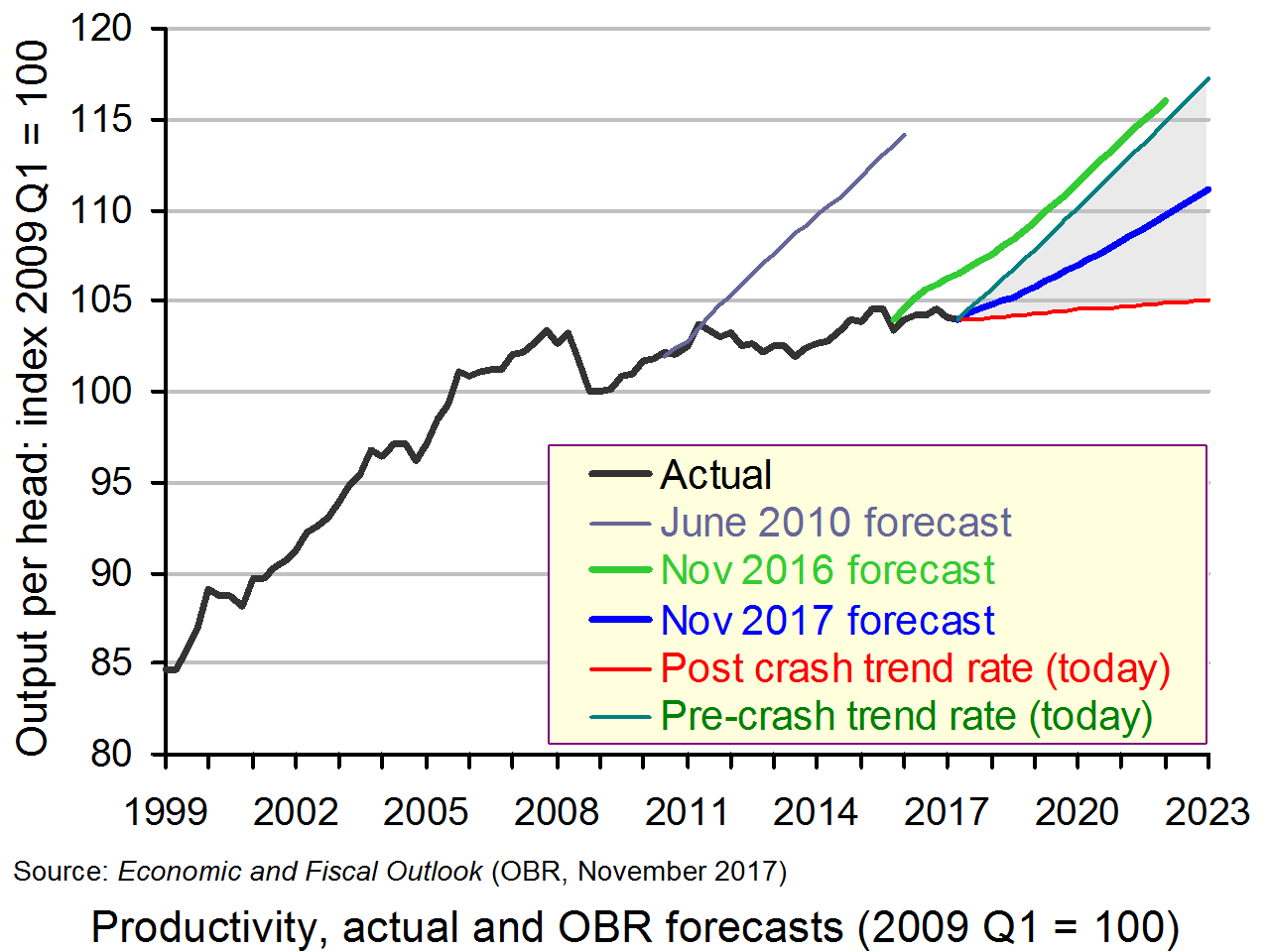 Although other countries’ productivity growth has also slowed since the financial crisis, it has slowed more in the UK and from a lower base – and is now forecast to rebound less quickly.
Although other countries’ productivity growth has also slowed since the financial crisis, it has slowed more in the UK and from a lower base – and is now forecast to rebound less quickly.
For the past few years the OBR has been forecasting that productivity growth would return to the trend rate of just over 2% that the UK achieved prior to 2008. For example, the forecasts it made in June 2010 are shown by the grey line in the chart, which were based on the pre-crash trend rate of growth in productivity (click on chart to enlarge). And the forecasts it made in November 2016 are shown by the pale green line. Yet each year productivity has hardly changed at all. Today output per hour is less than 1% above its level in 2008.
Now the OBR believes that poorer productivity growth will persist. It is still forecasting an increase (the blue line in the chart) – but by 0.7 of a percentage point less than it was forecasting a year ago (the pale green line): click here for a PowerPoint of the chart.
We have assumed that productivity growth will pick up a little, but remain significantly lower than its pre-crisis trend rate throughout the next five years. On average, we have revised trend productivity growth down by 0.7 percentage points a year. It now rises from 0.9 per cent this year to 1.2 per cent in 2022. This reduces potential output in 2021-22 by 3.0 per cent. The ONS estimates that output per hour is currently 21 per cent below an extrapolation of its pre-crisis trend. By the beginning of 2023 we expect this to have risen to 27 per cent.
Why has there been such weak productivity growth?
Weak productivity growth has been caused by a mixture of factors.
Perhaps the most important is that investment as a percentage of GDP has been lower than before the financial crisis and lower than in other countries. Partly this has been caused by a lack of funding for investment as banks have sought to rebuild their capital and have cut down on riskier loans. Partly it has been caused by a lack of demand for investment, given sluggish rates of economic growth and the belief that austerity will continue.

And it is not just private investment. Public-sector investment in transport infrastructure, housing and education and training has been lower than in other countries. Indeed, the poor training record and low skill levels in the UK are main contributors to low productivity.
The fall in the pound since the Brexit vote has raised business costs and further dampened demand as incomes have been squeezed.
Another reason for low productivity growth has been that employers have responded to weak demand, not by laying off workers and thereby raising unemployment, but by retaining low-productivity workers on low wages. Another has been the survival of ‘zombie’ firms, which, by paying low wages and facing ultra-low interest rates, are able to survive competition from firms that do invest.
Why is weak productivity growth forecast to continue?
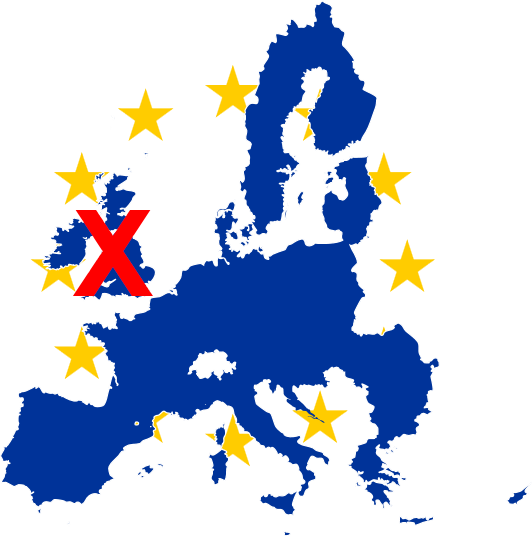 Looking forward, the nature of the Brexit deal will impact on confidence, investment, wages and growth. If the deal is bad for the UK, the OBR’s forecasts are likely to be too optimistic. As it is, uncertainty over the nature of the post-Brexit world is weighing heavily on investment as some businesses choose to wait before committing to new investment.
Looking forward, the nature of the Brexit deal will impact on confidence, investment, wages and growth. If the deal is bad for the UK, the OBR’s forecasts are likely to be too optimistic. As it is, uncertainty over the nature of the post-Brexit world is weighing heavily on investment as some businesses choose to wait before committing to new investment.
On the other hand, exports may rise faster as firms respond to the depreciation of the pound and this may stimulate investment, thereby boosting productivity.
Another factor is the effect of continuing tight Budgets. There was some easing of austerity in this Budget, as the Chancellor accepted a slower reduction in the deficit, but government spending will remain tight and this is likely to weigh on growth and investment and hence productivity.
But this may all be too gloomy. It is very difficult to forecast productivity growth, especially as it is hard to measure output in much of the service sector. It may be that the productivity growth forecasts will be revised up before too long. For example, the benefits from new technologies, such as AI, may flow through more quickly than anticipated. But they may flow through more slowly and the productivity forecasts may have to be revised down even further!
Articles
The OBR’s productivity “forecast” Financial Times, Kadhim Shubber
U.K. Faces Longest Fall in Living Standards on Record Bloomberg, Simon Kennedy and Thomas Penny (23/11/17)
Britain’s Productivity Pain Costs Hammond $120 Billion Bloomberg, Fergal O’Brien (22/11/17)
OBR slashes Britain’s growth forecast on sluggish productivity and miserly pay The Telegraph, Tim Wallace (22/11/17)
Budget 2017: Stagnant earnings forecast ‘astonishing’ BBC News (23/11/17)
Economists warn Budget measures to lift productivity fall short Financial Times, Gavin Jackson and Gill Plimmer (22/11/17)
Why the economic forecasts for Britain are so apocalyptic – and how much Brexit is to blame Independent, Ben Chu (24/11/17)
Growth holds steady as economists doubt OBR’s gloom The Telegraph, Tim Wallace (23/11/17)
Britain’s debt will not fall to 2008 levels until 2060s, IFS says in startling warning Independent, Lizzy Buchan (23/11/17)
Philip Hammond’s budget spots Britain’s problems but fails to fix them The Economist (22/11/17)
Debunking the UK’s productivity problem The Conversation, Paul Lewis (24/11/17)
Budget 2017: experts respond The Conversation (22/11/17)
Autumn Budget 2017 Forecasts Mean ‘Longest Ever Fall In Living Standards’, Says Resolution Foundation Huffington Post, Jack Sommers (23/11/17)
It May Just Sound Like A Statistic, But Productivity Growth Matters For All Of Us Huffington Post, Thomas Pope (24/11/17) (see also)
UK prospects for growth far weaker than first predicted, says OBR The Guardian, Angela Monaghan (22/11/17)
UK faces two decades of no earnings growth and more austerity, says IFS The Guardian, Phillip Inman (23/11/17)
Age of austerity isn’t over yet, says IFS budget analysis The Guardian, Larry Elliott (23/11/17)
Summary of Budget measures
Budget 2017: FT experts look at what it means for you Financial Times (24/11/17)
Official Documents
Autumn Budget 2017 HM Treasury (22/11/17)
Economic and fiscal outlook – November 2017 Office for Budget Responsibility (22/11/17)
IFS analysis
 Autumn Budget 2017 Institute for Fiscal Studies (23/11/17)
Autumn Budget 2017 Institute for Fiscal Studies (23/11/17)
Questions
- What measures of productivity are there other than output per hour? Why is output per hour normally the preferred measure of productivity?
- What factors determine output per hour?
- Why have forecasts of productivity growth rates been revised downwards?
- What are the implications of lower productivity growth for government finances?
- What could cause an increase in output per hour? Would there be any negative effects from these causes?
- What policies could the government pursue to increase productivity? How feasible are these policies? Explain.
- Would it matter if the government increased borrowing substantially to fund a large programme of public investment?
 We are coming into the big spending season, with Black Friday, Cyber Monday, the run-up to Christmas and then the winter sales. So will we all be rational maximisers and weigh up the utility we expect to receive from items against the price we pay (plus any other cost, such as time spent searching/shopping)? Or will we use a set of heuristics which make life easier and that we have found to be useful in helping us choose – heuristics such as buying things we’ve liked before, or going for things on special offer?
We are coming into the big spending season, with Black Friday, Cyber Monday, the run-up to Christmas and then the winter sales. So will we all be rational maximisers and weigh up the utility we expect to receive from items against the price we pay (plus any other cost, such as time spent searching/shopping)? Or will we use a set of heuristics which make life easier and that we have found to be useful in helping us choose – heuristics such as buying things we’ve liked before, or going for things on special offer?
The answer is that we do probably use a set of heuristics, at least for many items. And don’t the retailers and the marketing firms they employ know this!
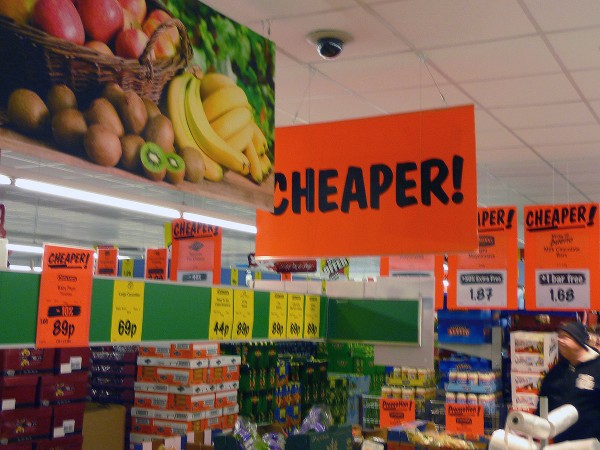
They will use all sorts of tricks of the trade to persuade us to part with our money. These tricks are designed to nudge us (or push us), without us feeling manipulated or conned – at least until we’ve bought their product.
And the tricks are getting more sophisticated. They include special offers which are not as good as they seem, time-limited offers which stimulate us to buy quickly without carefully thinking about what we’re doing, cunning positioning of products in shops to encourage us to buy things we had not planned to buy, adverts which play to our idealised perceptions or the ‘good life’ or what we would like to achieve, and packaging or display which make the product seem better than it is.
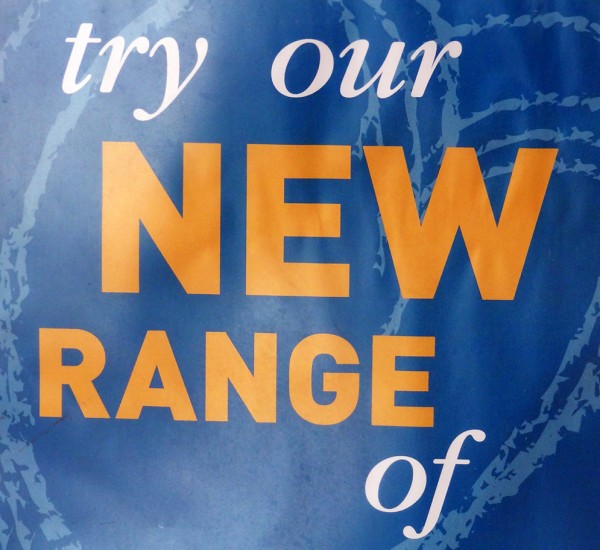
Also we are increasingly faced with targeted advertising where our smart devices capture information about our spending habits and tastes through our previous online spending or our search behaviour. This is then fed to advertisers to tailor adverts specifically to us on our mobiles, tablets, laptops and even, soon, on our smart TVs.
We may have a general desire to maximise utility from our spending, but market failures, such as consumers having imperfect information about products and a present bias (see also) in decision making, make us easy targets for the advertising and marketing industry. They understand the heuristics we use and try to take maximum advantage of them.
Happy shopping!
Articles
How shops use tricks to get you spending The Conversation, Cathrine Jansson-Boyd (16/11/17)
ColourPop looks to Qubit for next-gen personalization guidance Retail Dive, Dan O’Shea (13/6/17)
Channel 4 to offer 100% ad targeting across All 4 platform, seeking partners for linear equivalent The Drum, Jessica Goodfellow (14/11/17)
How Google aims to bring TV advertising into the 21st century The Drum, Ronan Shields (19/10/17)
How to Use Heuristics to Your Marketing Advantage MarketingProfs, Cam Secore (12/11/15)
Questions
- Does the use of heuristics contradict the assumption that consumers behave rationally?
- Give some examples of heuristics that you yourself use.
- Other than those identified above and in the first article, what ‘tricks’ might companies play on you to persuade you to buy their products?
- Is advertising personally targeted to individual consumers desirable for them?
- Give some examples of present bias in people’s behaviour.
- What factors should a retailer take into account when deciding whether to make pre-Christmas discounts?
- Explain what is meant by ‘affect heuristic’ and how the advertising industry uses the concept in setting the background to or scenario of an advertisement.
- Have you ever been persuaded into buying something you didn’t want? Why were you persuaded?
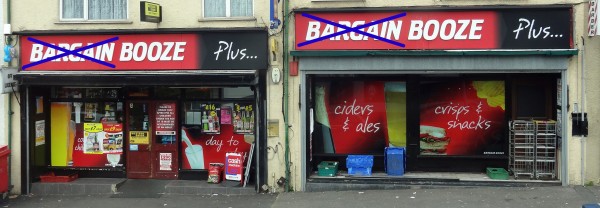 In 2012, the Scottish Parliament voted to introduce a minimum unit price for alcoholic drinks. The Scotch Whisky Association along with others appealed against the legislation, but on 15 November 2017 the UK Supreme Court ruled unanimously that the legislation does not breach European Union law. It is thus likely that, after consultation, a 50p minimum unit price will be introduced, making Scotland the first country in the world to introduce minimum pricing for alcohol.
In 2012, the Scottish Parliament voted to introduce a minimum unit price for alcoholic drinks. The Scotch Whisky Association along with others appealed against the legislation, but on 15 November 2017 the UK Supreme Court ruled unanimously that the legislation does not breach European Union law. It is thus likely that, after consultation, a 50p minimum unit price will be introduced, making Scotland the first country in the world to introduce minimum pricing for alcohol.
As we saw in a previous blog, Alcohol minimum price, the aim is to prevent the sale of really cheap drinks in supermarkets and other outlets. For example, three-litre bottles of strong cider can be sold for as little as £3.59. Sometimes supermarkets offer multibuys which are heavily discounted. The idea of minimum pricing is to stop these practices without affecting ‘normal’ prices. For example, the legislation will not affect prices in pubs, which are already more than 50p per unit of alcohol.
The following table shows how much prices would rise for various types of drink when compared to current cheap supermarket prices. The biggest percentage effect is for cheap, strong cider and beer.
|
Strength |
Size |
Units of alcohol |
Current price |
New minimum price |
| Cheap strong cider |
7.5% |
3 litres |
22.5 |
£3.50 |
£11.25 |
| Cheap wine |
13% |
750ml |
9.75 |
£3.99 |
£4.88 |
| Cheap beer/lager (normal) |
4% |
4 × 440ml |
7.04 |
£2.50 |
£3.52 |
| Cheap beer/lager (strong) |
8% |
4 × 500ml |
16 |
£3.50 |
£8.00 |
| Cheap spirits |
37.5% |
70cl |
26.25 |
£10.00 |
£13.13 |
| Cheap strong spirits |
50% |
70cl |
35 |
£12.00 |
£17.50 |
The hope is that by preventing the sale of really cheap drinks in supermarkets, people will no longer be encouraged to ‘pre-load’, so that when they go out for the evening they are already drunk. It would also help to reduce the number of alcoholics amongst the poor.
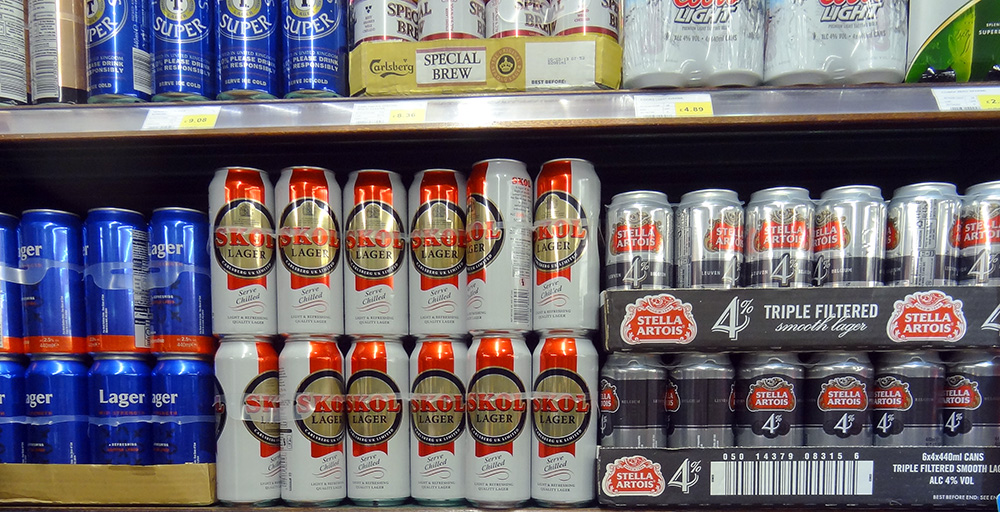
But this raises the question of equity. By targeting cheap drink, the policy is likely to hit the poor hardest. The question is whether this will simply lead to alcoholics on low incomes cutting down on other things, such as food and clothing for themselves and their children.
How successful, then, will such a policy be in cutting down drunkenness and the associated anti-social behaviour in many Scottish towns and cities, especially on Friday and Saturday nights? This will depend on the price elasticity of demand.
Videos and podcasts
 Scotland first country to introduce minimum alcohol price Channel 4 News, Fatima Manji (15/11/17)
Scotland first country to introduce minimum alcohol price Channel 4 News, Fatima Manji (15/11/17)
 The story of how Scotland brought in minimum pricing on alcoh The Scotsman, Ross McCafferty (15/11/17)
The story of how Scotland brought in minimum pricing on alcoh The Scotsman, Ross McCafferty (15/11/17)
 Supreme Court rejects challenge against plans for minimum alcohol pricing in Scotland ITV News, Peter Smith (15/11/17)
Supreme Court rejects challenge against plans for minimum alcohol pricing in Scotland ITV News, Peter Smith (15/11/17)
 Scotland getting the all-clear for minimum alcohol pricing as judges reject appeal Heart Scotland News, Connor Gillies (15/11/17)
Scotland getting the all-clear for minimum alcohol pricing as judges reject appeal Heart Scotland News, Connor Gillies (15/11/17)
Articles
Alcohol minimum unit pricing to go ahead Scottish Government: news (15/11/17)
Scottish alcohol price survey 2016 Alcohol Focus Scotland (2016)
Minimum pricing Alcohol Focus Scotland (2017)
Supreme Court backs Scottish minimum alcohol pricing BBC News (15/11/17)
Supreme Court backs Scottish minimum alcohol pricing plans Out-Law.com (15/11/17)
Go-ahead for minimum alcohol pricing British Medical Association (BMA), Jennifer Trueland (15/11/17)
Expert reaction to UK supreme court ruling that the Scottish government can set a minimum price for alcohol, rejecting a challenge by the Scotch Whisky Association Science Media Centre (15/11/17)
Scotland to become first country with minimum price for alcohol sales Independent, Alex Matthews-King (15/11/17)
Scotland leading the world over minimum alcohol price ITV News (15/11/17)
Campaigners urge minimum alcohol price in England after Scottish ruling The Guardian, Severin Carrell (15/11/17)
Scottish ‘booze cruises’ to England predicted as minimum pricing introduced The Telegraph, Olivia Rudgard (15/11/17)
Questions
- Draw a diagram to illustrate the effect of a minimum price per unit of alcohol on (a) cheap cider; (b) good quality wine.
- What would be the likely effects of a 50p per unit minimum price on the pub trade?
- How is the price elasticity of demand for alcoholic drinks relevant to determining the success of minimum pricing?
- What determines the price elasticity of demand for cheap alcoholic drinks?
- Compare the effects on alcohol consumption of imposing a minimum unit price of alcohol with raising the duty on alcoholic drinks. What are the revenue implications of the two policies for the government?
- What externalities are involved in the consumption of alcohol? How could a socially efficient price for alcohol be determined?
- Could alcohol consumption be described as a ‘de-merit good’? Explain.
- Other than high minimum prices and taxation, what other policies could be used to (a) tackle binge drinking; (b) tackle the problem of alcoholism?
- What will determine the number of people travelling from Scotland to England to buy cheaper alcoholic drinks?
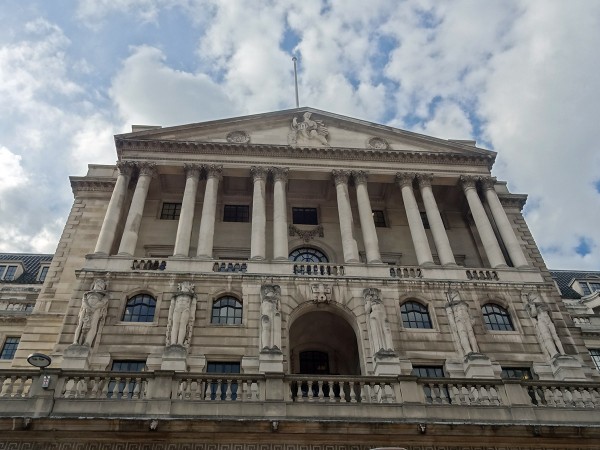 On 2 November, the Bank of England raised Bank rate from 0.25% to 0.5% – the first rise since July 2007. But was now the right time to raise interest rates? Seven of the nine-person Monetary Policy Committee voted to do so; two voted to keep Bank Rate at 0.25%.
On 2 November, the Bank of England raised Bank rate from 0.25% to 0.5% – the first rise since July 2007. But was now the right time to raise interest rates? Seven of the nine-person Monetary Policy Committee voted to do so; two voted to keep Bank Rate at 0.25%.
Raising the rate, on first sight, may seem a surprising decision as growth remains sluggish. Indeed, the two MPC members who voted against the rise argued that wage growth was too weak to justify the rise. Also, inflation is likely to fall as the effects of the Brexit-vote-induced depreciation of sterling on prices feeds through the economy. In other words, prices are likely to settle at the new higher levels but will not carry on rising – at least not at the same rate.
So why did the other seven members vote to raise Bank Rate. There are three main arguments:
|
|
| • |
Inflation, at 3%, is above the target of 2% and is likely to stay above the target if interest rates are not raised. |
| • |
There is little spare capacity in the economy, with low unemployment. There is no shortage of aggregate demand relative to output. |
| • |
With productivity growth being negligible and persistently below that before the financial crisis, aggregate demand, although growing slower than in the past, is growing excessively relative to the growth in aggregate supply. |
As the Governor stated at the press conference:
In many respects, the decision today is straightforward: with inflation high, slack disappearing, and the economy growing at rates above its speed limit, inflation is unlikely to return to the 2% target without some increase in interest rates.
But, of course, the MPC’s forecasts may turn out to be incorrect. Many things are hard to predict. These include: the outcomes of the Brexit negotiations; consumer and business confidence and their effects on consumption and investment; levels of growth in other countries and their effects on UK exports; and the effects of the higher interest rates on saving and borrowing and hence on aggregate demand.
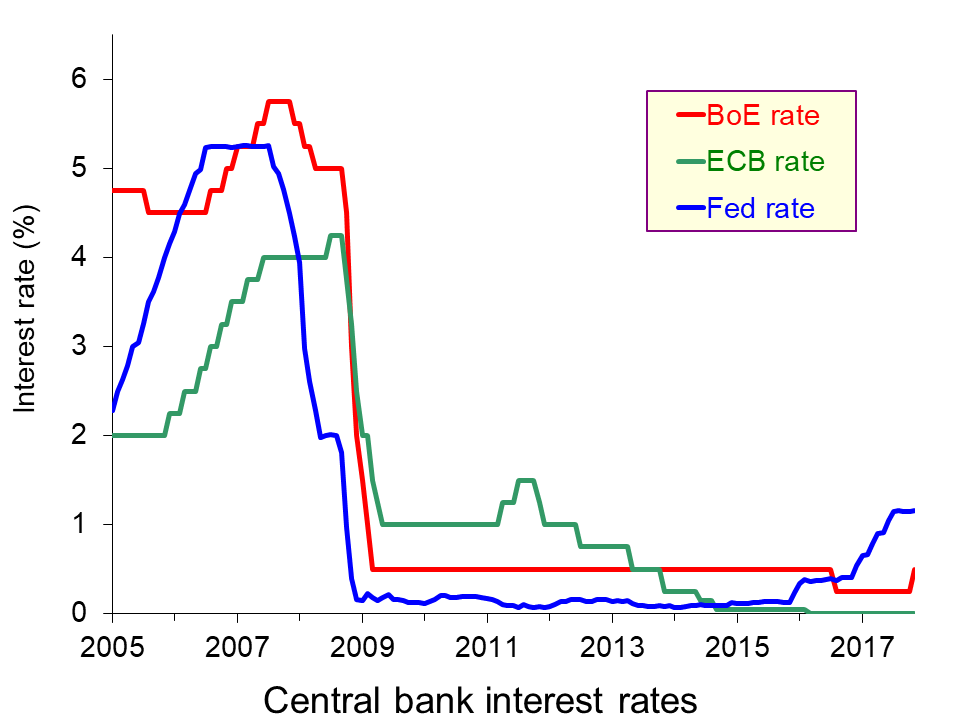 The Bank of England is well aware of these uncertainties. Although it plans two more rises in the coming months and then Bank Rate remaining at 1% for some time, this is based on its current assessment of the outlook for the economy. If circumstances change, the Bank will adjust the timing and total amount of future interest rate changes.
The Bank of England is well aware of these uncertainties. Although it plans two more rises in the coming months and then Bank Rate remaining at 1% for some time, this is based on its current assessment of the outlook for the economy. If circumstances change, the Bank will adjust the timing and total amount of future interest rate changes.
There are, however, dangers in the rise in interest rates. Household debt is at very high levels and, although the cost of servicing these debts is relatively low, even a rise in interest rates of just 0.25 percentage points can represent a large percentage increase. For example, a rise in a typical variable mortgage interest rate from 4.25% to 4.5% represents a 5.9% increase. Any resulting decline in consumer spending could dent business confidence and reduce investment.
Nevertheless, the Bank estimates that the effect of higher mortgage rates is likely to be small, given that some 60% of mortgages are at fixed rates. However, people need to refinance such rates every two or three years and may also worry about the rises to come promised by the Bank.
Articles
Bank of England deputy says interest rate rise means pain for households and more hikes could be in store Independent, Ben Chapman (3/11/17)
UK interest rates: Bank of England shrugs off Brexit nerves to launch first hike in over a decade Independent, Ben Chu (2/11/17)
 Bank of England takes slow lane after first rate hike since Reuters, David Milliken, William Schomberg and Julian Satterthwaite (2/11/17)
Bank of England takes slow lane after first rate hike since Reuters, David Milliken, William Schomberg and Julian Satterthwaite (2/11/17)
First UK rate rise in a decade will be a slow burn Financial Times, Gemma Tetlow (2/11/17)
The Bank of England’s Rate Rise Could Spook Britain’s Economy Bloomberg, Fergal O’Brien and Brian Swint (3/11/17)
 Bank of England hikes rates for the first time in a decade CNBC, Sam Meredith (2/11/17)
Bank of England hikes rates for the first time in a decade CNBC, Sam Meredith (2/11/17)
Interest rates rise in Britain for the first time in a decade The Economist (2/11/17)
Bank of England publications
 Bank of England Inflation Report Press Conference, Opening Remarks Financial Times on YouTube, Mark Carney (2/11/17)
Bank of England Inflation Report Press Conference, Opening Remarks Financial Times on YouTube, Mark Carney (2/11/17)
Bank of England Inflation Report Press Conference, Opening Remarks Bank of England, Mark Carney (2/11/17)
 Inflation Report Press Conference (full) Bank of England on YouTube (2/11/17)
Inflation Report Press Conference (full) Bank of England on YouTube (2/11/17)
Inflation Report Bank of England (November 2017)
Monetary Policy Summary and minutes of the Monetary Policy Committee meeting ending on 1 November 2017 Bank of England (2/11/17)
Questions
- Why did the majority of MPC members feel that now was the right time to raise interest rates whereas a month ago was the wrong time?
- Why did the exchange rate fall when the announcement was made?
- How does a monetary policy of targeting the rate of inflation affect the balance between aggregate demand and aggregate supply?
- Can monetary policy affect potential output, or only actual output?
- If recent forecasts have downgraded productivity growth and hence long-term economic growth, does this support the argument for raising interest rates or does it suggest that monetary policy should be more expansionary?
- Why does the MPC effectively target inflation in the future (typically in 24 months’ time) rather than inflation today? Note that Mark Carney at the press conference said, “… it isn’t so much where inflation is now, but where it’s going that concerns us.”
- To what extent can the Bank of England’s monetary policy be described as ‘discretionary’?
 In three interesting articles, linked below, the authors consider the state of economies since the financial crisis of 2007–8 and whether governments have the right tools to tackle future economic shocks.
In three interesting articles, linked below, the authors consider the state of economies since the financial crisis of 2007–8 and whether governments have the right tools to tackle future economic shocks.
There have been some successes over the past 10 years, in particular keeping inflation close to central bank targets despite considerable shocks (see the Vox article). Also unemployment has fallen in most countries and to very low levels in some, including the UK.
But economic growth has generally remained well below the levels prior to the financial crisis, with low productivity growth being the main culprit. Indeed, many people have seen no growth at all in their real incomes over the past 10 years, with low unemployment being bought at the cost of a growth in zero-hour contracts and work in the gig economy. And what economic growth we have seen has been largely the result of taking up slack through unprecedentedly loose monetary policy.
Fiscal policy, except in the period directly following the financial crisis, has generally been tight as governments have sought to reduce their deficits and slow down the growth in their debt.
But what will happen if economies once more slow? Or, worse still, what will happen if there is another global recession? Do countries have the policies to tackle the problem this time round?
 Quantitative easing could be used again, but many economists believe that it will have more limited scope if confined to the purchase of assets in the secondary market. Also, there is little scope for reducing interest rates, which, despite some modest rises in the USA, remain at close to zero in most developed countries.
Quantitative easing could be used again, but many economists believe that it will have more limited scope if confined to the purchase of assets in the secondary market. Also, there is little scope for reducing interest rates, which, despite some modest rises in the USA, remain at close to zero in most developed countries.
One possibility is a combination of monetary and fiscal policy, where new money is used to finance government expenditure on infrastructure, such as road and rail, broadband, green energy, hospitals and schools and colleges. This would avoid the need for governments to borrow on open markets as the spending would be financed by new government securities purchased directly by the central bank.
An objection to such ‘people’s quantitative easing‘, as it has been dubbed, is that it would effectively end the independence of central banks. This independence has been credited by many with giving central banks credibility in controlling inflation. Would inflationary expectations rise with people’s quantitative easing and, with it, actual inflation? A lot would depend on the extent to which this QE could still be conducted within a framework of targeting inflation and whether people’s expectations of inflation could be managed jointly by the government and central bank.
Articles
How should recessions be fought when interest rates are low? The Economist. Free exchange (21/10/17)
The economy is failing. We need to think radically about how to fix it The Guardian, Liam Byrne (25/10/17)
Elusive inflation and the Great Recession Vox, David Miles, Ugo Panizza, Ricardo Reis, Ángel Ubide (25/10/17)
Videos
 Economics since the crisis Vox on YouTube. Charles Goodhart (11/10/17)
Economics since the crisis Vox on YouTube. Charles Goodhart (11/10/17)
 Is the system broken? Vox on YouTube, Anat Admati (12/10/17)
Is the system broken? Vox on YouTube, Anat Admati (12/10/17)
 Signs of a crisis Vox on YouTube, Christian Thimann (19/10/17)
Signs of a crisis Vox on YouTube, Christian Thimann (19/10/17)
 Policy stances since 2007 Vox on YouTube, Paul Krugman (29/10/17)
Policy stances since 2007 Vox on YouTube, Paul Krugman (29/10/17)
 Did policymakers get it right? Vox on YouTube, Paul Krugman (4/10/17)
Did policymakers get it right? Vox on YouTube, Paul Krugman (4/10/17)
Questions
- Why, during the next recession, will the “zero lower bound” (ZLB) on interest rates almost certainly bite again?
- Why would the scope for QE, as conducted up to now, be more limited in the future if a recession were to occur?
- Why have central banks appeared to have been so successful in keeping inflation close to target despite negative and positive demand- and supply-side shocks?
- Why are the pressures on government expenditure likely to increase in the coming years?
- How would a temporary price-level target help to tackle a recession when the economy next bumps into the ZLB? What would limit its success?
- Is it appropriate for central banks to stick to an inflation target in times when there is an adverse supply-side shock resulting in cost-push inflation?
- Why might monetary policy conducted in a framework of inflation targeting tend to lessen the impact of a fiscal stimulus?
- What are the arguments for and against relaxing central bank independence and pursuing a co-ordinated fiscal and monetary policy?
- What are the arguments for and against using helicopter money to boost private expenditure during a future recession where interest rates are already near the ZLB?
- What are the arguments for and against using ‘people’s QE’?
 In delivering his Budget on 22 November, Philip Hammond reported that the independent Office for Budget Responsibility had revised down its forecasts of growth in productivity and real GDP, and hence of earnings growth.
In delivering his Budget on 22 November, Philip Hammond reported that the independent Office for Budget Responsibility had revised down its forecasts of growth in productivity and real GDP, and hence of earnings growth. Although other countries’ productivity growth has also slowed since the financial crisis, it has slowed more in the UK and from a lower base – and is now forecast to rebound less quickly.
Although other countries’ productivity growth has also slowed since the financial crisis, it has slowed more in the UK and from a lower base – and is now forecast to rebound less quickly. Looking forward, the nature of the Brexit deal will impact on confidence, investment, wages and growth. If the deal is bad for the UK, the OBR’s forecasts are likely to be too optimistic. As it is, uncertainty over the nature of the post-Brexit world is weighing heavily on investment as some businesses choose to wait before committing to new investment.
Looking forward, the nature of the Brexit deal will impact on confidence, investment, wages and growth. If the deal is bad for the UK, the OBR’s forecasts are likely to be too optimistic. As it is, uncertainty over the nature of the post-Brexit world is weighing heavily on investment as some businesses choose to wait before committing to new investment. Autumn Budget 2017 Institute for Fiscal Studies (23/11/17)
Autumn Budget 2017 Institute for Fiscal Studies (23/11/17)












